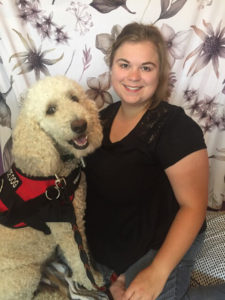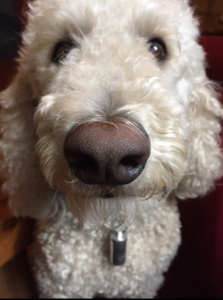February 27, 2018
Did you know some dogs can be trained to detect, and help their owners through, certain fluctuations in physical and mental health?
I had no idea what service dogs were capable of until my cousin Rebecca was connected with one and her whole life changed! I realized there was so much I didn’t know about support animals; I had a lot of questions for her, and she was happy to answer them.
 Tell us a little about yourself and your dog.
Tell us a little about yourself and your dog.
My name is Rebecca; I’m a college student. I have a service dog named Hannah; she is a 4-year-old Standard Poodle. I have Panic Disorder, which means I have frequent panic attacks that impair my ability to function. Hannah helps me live a happy, independent life.
How long have you had Hannah? What was the process of getting her like? Did you train her?
Hannah and I will celebrate our 1-year anniversary in March, 2018. As my mental health declined, I exhausted every option I could think of; when therapies, medications, and lifestyle changes failed, I explored the option of a service animal. I found a training company with good integrity, saved up to afford training costs, waited a few months for my trainer to find a suitable dog, and then Hannah was in intensive training for many months.
While not necessary to use a professional training service, I chose to work with a company called Buckeye Service Dogs to help Hannah learn her tasks. It’s easier for professionals to identify dogs that will make happy service dogs. Hannah was a good candidate because she was medium energy level, loved to learn, old enough to start training right away, confident, no aggression, and very smart. Intelligent dogs need lots of mental stimulation, so Hannah loves to work.
The first few weeks with Hannah were difficult, but we learned how to work as a team, and my life began to change.
What types of people qualify for a service dog? What does she do for you?
You might qualify for a service dog if you have a disability that impairs daily functioning. There are many types of service dogs beyond seeing-eye-dogs! Man’s best friend can be trained to pick up objects, open doors, and brace people with mobility issues. They can find exits, sniff out intruders, and alert their handlers to allergens. Some dogs can even detect when a seizure, low blood sugar, or migraine is coming! And service dogs help people with psychiatric disabilities, too! They keep people with autism from fleeing from safety, help people with panic attacks navigate social areas, wake people with PTSD when they have nightmares, and more.
My Panic Disorder impairs daily functioning because attacks are so frequent and severe. Hannah helps me function independently in public. My panic attacks prevent me from doing simple tasks in day-to-day life like concentrate in class, navigate a noisy grocery store, or even hang out with friends. Hannah keeps me safe and calm when I’m having a panic attack through some of the following tasks:
– Uses deep pressure therapy to keep me still and calm
– Blocks people from touching me in crowded areas
– Intervenes self injurious behaviors
– Puts her nose where I can feel her breath to regulate my breathing
– Provides a source of focus and familiar sensory inputs in moments of overstimulation
– Most importantly, Hannah responds to my symptoms of distress before they become a full panic attack.
Hannah also helps me when I have migraines by bringing me water and picking up objects so I can lay in bed and rest.
Are there multiple types of support animals? What are the differences between them?
Yes! There are three types of support animals: Service animals, emotional support animals, and therapy animals. If someone finds animals to be soothing to their overall wellbeing, then a doctor might prescribe an emotional support animal (ESA). ESAs are protected under the Fair Housing Act, so people can have access to this step of their treatment wherever they live. ESAs are not trained for public access, and they are not permitted in public places unless pets are allowed.
Therapy animals are well-trained companion animals. They provide support to many people; their handlers will take them to places like hospitals and senior living facilities to provide a fun, calming companion.
Service dogs are trained to do specific tasks for one individual. They are not pets, but actually considered medical equipment and are protected under the federal Americans with Disabilities Act. Service dogs are allowed access to anywhere that their handlers can go, including restaurants, stores, movie theaters, etc. They must go through extensive training.
Below is a chart to keep all this organized.
| Service Dogs | Therapy Dogs | Emotional Support Animals | |
| Public access rights are covered by the ADA (Americans with Disabilities Act) | ✓ | ||
| Provides emotional support to many people | ✓ | ✓ | |
| Specifically trained to assist just one person | ✓ | ||
| Needs to tolerate wide variety of environments and experiences | ✓ | ✓ | |
| Primary function: provide emotional support through companionship | ✓ | ✓ | |
| Primary function: mitigate a disability | ✓ |
What is your daily routine with Hannah? What kinds of gear does she have when you leave the house?
During the day, Hannah accompanies me to work and class. Hannah wears a vest that labels her as a service animal. She carries some things in her vest pockets, like a collapsible water bowl, waste bags, and business cards that explain the ADA law. Sometimes Hannah also wears boots to protect from the snow or hot concrete, a raincoat, or winter jacket. She wears a capsule on her collar with medicine for me.
In the afternoon, Hannah has off-duty time at home. We go for walks, run in the yard, cuddle, and play with toys! Hannah will still do her tasks without her vest on if I need her to, but she has lots of time to be a “normal dog.”
Are there skills or tasks that you work on with her?
Service dogs need daily practice sessions to keep up on their tasks. Hannah loves to train, so we pretend it’s a game! Daily training also allows for Hannah to learn new skills and adapt her tasks as my health changes over time.
What are some common misconceptions about service dogs?
- “It’s not fair to make a dog work!” Not all dogs would be happy as service animals, but lots of dogs love to work! Dogs like to learn, please, perform, be with their person, and go on adventures. Hannah definitely prefers the daily life as a service dog rather than being bored at home. And remember: even working dogs get plenty of rest and playtime.
- “Golden Retrievers are the best breed for service work.” A dog’s ability to be a service animal is based on temperament, behavior, and training… not breed! Service animals can be any breed, even “bully” breeds, as long as they have the right temperament and training.
- “People with service animals are lucky because they get to bring their dog everywhere with them.” I am very lucky to have a tool that helps me function independently, but I am not lucky to have a disabling condition that requires a service dog.
- “She doesn’t look like she’s working, so I can pet her really quickly.” Even if service dogs don’t look like they are working, they might be doing something really important, like monitoring their handler’s blood sugar or staying ready to alert a deaf handler to an alarm. If you distract a service dog, they cannot do their job effectively, and it could be detrimental (or even deadly) for their handler.
- “She’s so cute, I need a picture!” It’s uncomfortable to have cameras pointed at us; ask before taking a picture!
- “She doesn’t look disabled, she doesn’t need a service dog.” Many disabilities are invisible; try not to make assumptions about a person’s health or needs based on their looks.
How should people react when they see someone with a service dog?
Remember that service dogs are working; do not distract them. This includes petting, talking, or making kissy noises. If you think the dog is cute, tell their handler. If you talk to the dog without addressing their handler you are not only distracting the dog, but also making the handler feel like their disability is all you see. Some handlers are happy to answer questions about the dog, but respect their privacy if they don’t want to talk. Understand if a handler doesn’t want to talk; you never know how many stares, questions, points, or pass-by-pettings they have dealt with that day. I advise people to treat Hannah like they would treat a wheelchair; you wouldn’t touch a wheelchair or secretly take pictures of it, would you?
Just one final question: who’s a good girl?
HANNAH!

The relationship between a service dog and their owner is beautifully deep and mutually enriching. Together Becca and Hannah are capable of anything! Go team!
Thanks to Aaron Taub, our Avondale and Irving Park walker, for conducting this interview, and Rebecca Benedict for her thoughtful answers. If you want to see more of Becca and Hannah you can follow them on Instagram @hannahservicedog.

Recent Comments